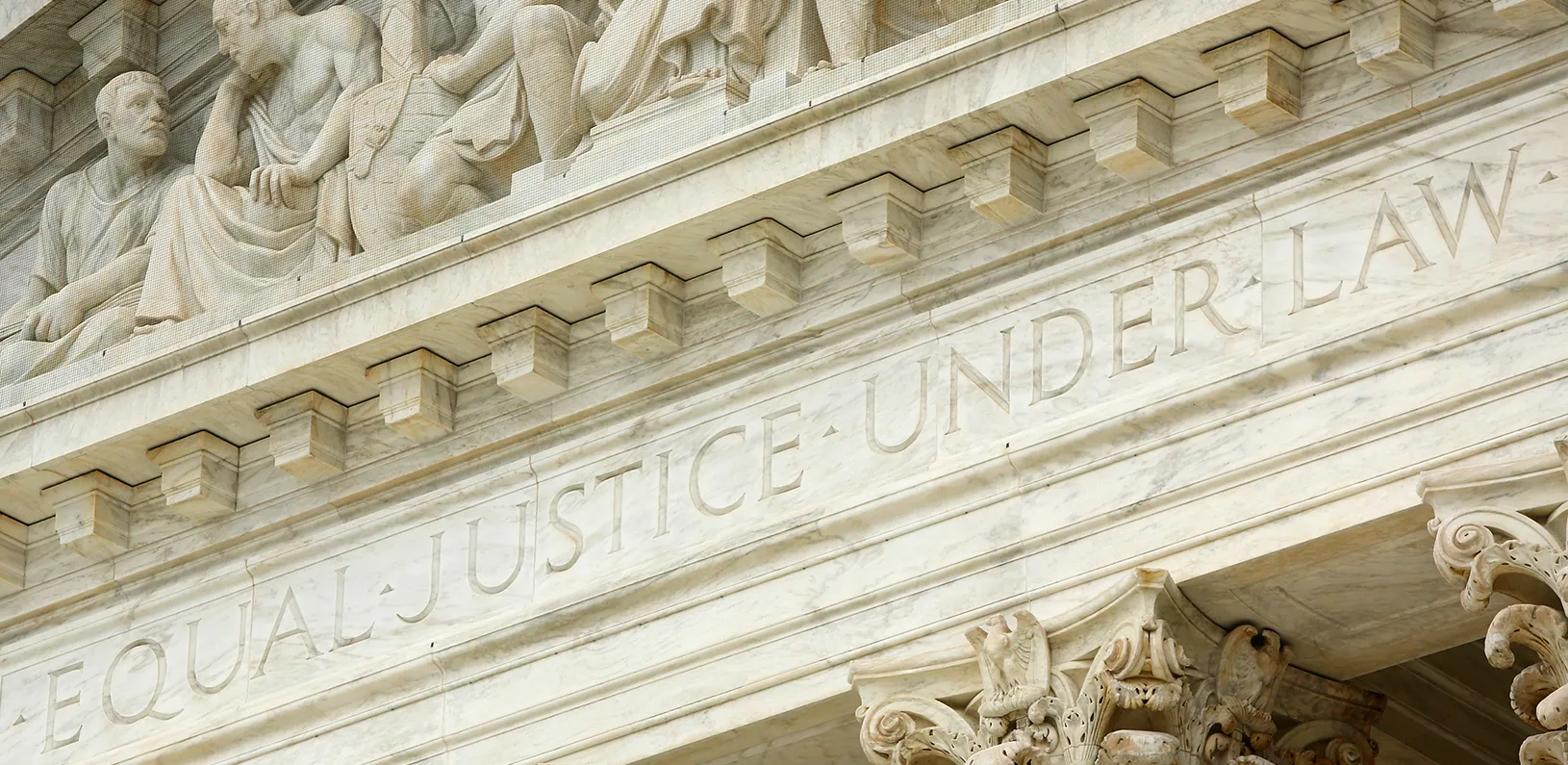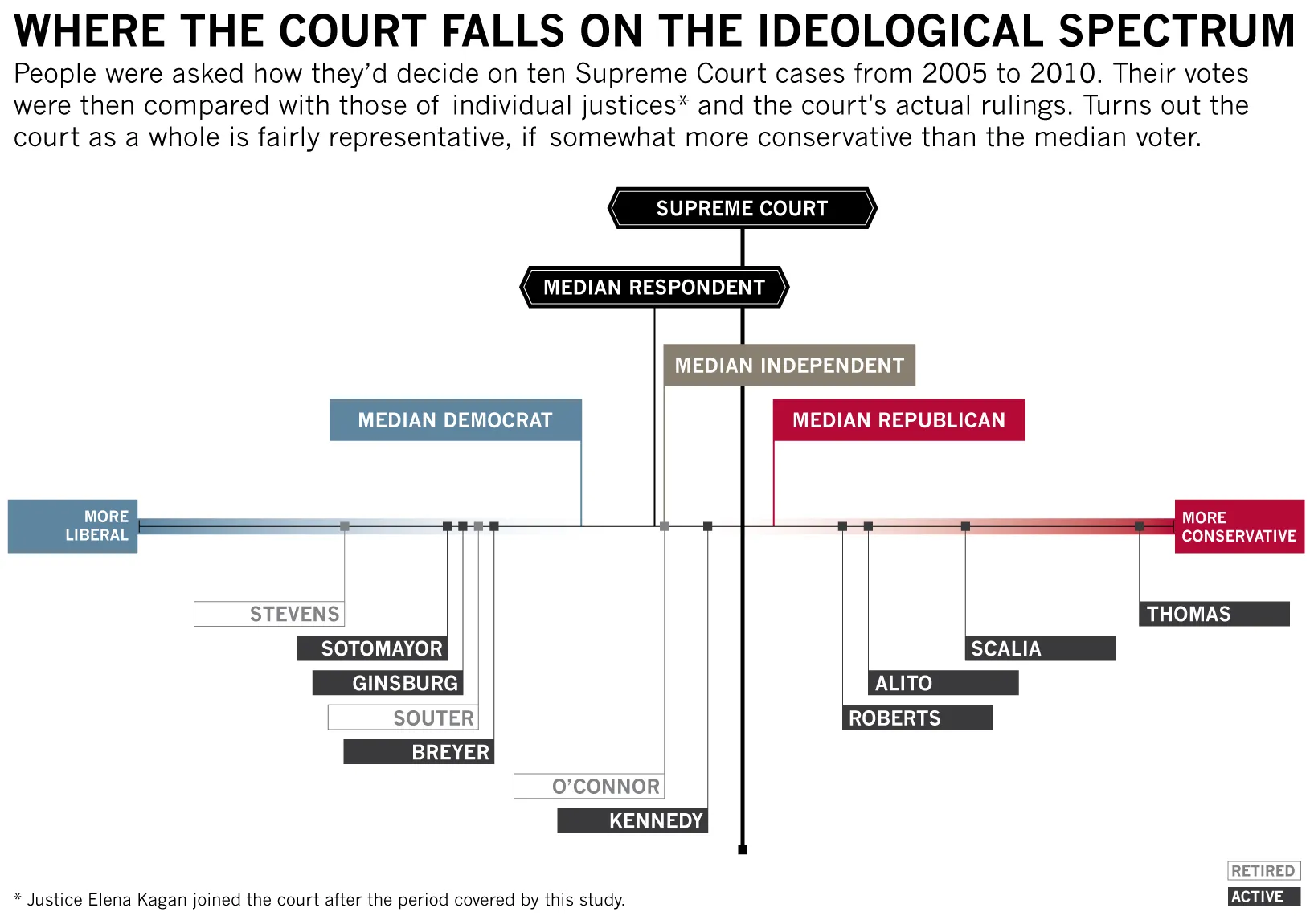Neil Malhotra: Debunking the Myth of the Liberal Supreme Court
A political economist looks at the relationship between public opinion and the high court.
March 17, 2015

How closely do the court’s opinions mirror public opinion? Closer than you might think. | Reuters/Jonathan Ernst
Is America’s highest court out of step with the heartland? Many conservatives think so, and for some that’s putting the case politely. Talk-radio host Mark Levin, author of a 2005 book titled Men in Black: How the Supreme Court Is Destroying America, sees it as the instrument of a “diabolical” back-door campaign to impose an elitist, left-wing agenda on the nation.
The usual charge in such accounts is judicial “activism,” or the notion that the Supreme Court exceeds its authority and tries to legislate from the bench. In practice the epithet is applied selectively, by liberals and conservatives alike, to whatever the speaker disagrees with. When the court gutted the Voting Rights Act in 2013, even Justice Ruth Ginsburg called the decision “stunning in terms of activism.” When it declined to review lower-court rulings allowing same-sex marriage in five states last October, Levin denounced its nonaction as “judicial tyranny.”
The Supreme Court is an easy target, says Neil Malhotra, professor of political economy at Stanford Graduate School of Business, because its nine justices are appointed rather than elected and serve for life. The framers of our government meant to insulate the court from political pressure. But as a consequence, some scholars say, the legitimacy of the institution in the minds of citizens is tenuous and provisional, always contingent on its hewing close to mainstream thinking.
If that’s true, the common belief that the Supreme Court leans left is indeed problematic. But are people’s perceptions accurate? Malhotra, along with Stephen Jessee of the University of Texas, Austin, set out to settle the question. They designed a method of quantifying ideological positions and applied it to a sample of 1,500 subjects, studying the court from 2005 to 2010 (see chart below).
The result? “The court is pretty close to the center of public opinion,” Malhotra says, “but a little to the right.”
Furthermore, Malhotra finds that those ideologically closest to the court approve of and trust it more, but they are less likely to support the court’s role as a protector of minority rights. This is because moderate citizens like that the court is also, on balance, moderate. But because they have majority viewpoints, they are less sensitive to minority concerns.
Taking the Same Test
The myth of the liberal court persists in part because it’s impossible to test by any standard that everyone can agree on. What one sees as moderately liberal, another sees as dangerously radical. With so many people getting their news through partisan channels nowadays, each side believes the center of gravity is closer to its own norms.
To get around that problem, Malhotra and Jessee selected 10 Supreme Court cases from 2005 to 2010, covering a range of issues, and asked their test subjects how they would have decided each one. In this way the researchers were able to place respondents and the court on a common scale. They could then measure the percentage of cases on which each person agreed or disagreed with the court and plot their “ideological distance” to the left or right of it.
What they found is that 64% of respondents — nearly two-thirds — tested as more liberal than the court, with the median voter falling near the court’s position but to the left.
Malhotra emphasizes that the scale itself has no meaning; what matters are the relative positions. “You can’t say whether the court itself is liberal or conservative. All you can say objectively is, is the Supreme Court representative? And overall, it is, yes. It’s somewhat more conservative than mass opinion, but almost everyone is within one standard deviation of the Court’s position.”
The researchers also plotted each of the individual justices on the same scale. Not surprisingly, they found a wide gap between Sonia Sotomayor on one end and Clarence Thomas on the other — much wider than between Democrats and Republicans in general.
“But Anthony Kennedy is fairly moderate,” Malhotra says. “He votes conservative maybe 60% of the time and liberal 40%. And because he’s the median voter, the swing vote, Kennedy essentially is the court. Well, it turns out the average person votes pretty much like Anthony Kennedy.”
Misjudging the Judges
Yet that’s not how we tend to see it. Test subjects were also asked for their own assessment of the Supreme Court’s record. Only 41% thought the court’s position was “about right”; 33% said it was too liberal, and 26% said it was too conservative. Not surprisingly, opinions were closely related to whether respondents identified as Democrat, Republican, or independent.
But then Malhotra and Jessee did something even more interesting. They compared each individual’s subjective assessment of the court (i.e., “too liberal” or “too conservative”) with their position on the ideological scale, as measured by their votes on the 10 test cases.
The results are striking: While most respondents accurately located the court in relation to their own views, those who misperceived it were nearly 10 times more likely to view it as too liberal rather than too conservative — in other words, thinking the court is to the left of them when it’s actually to the right. Fully 17% of people to the left of the court perceived it as too liberal.
The researchers also found that Republicans were much more likely to be wrong than Democrats. Nearly a third of Republican respondents were to the left of the court, and nearly half of those said the court was too liberal. A similar bias was evident among independents: 18% of those to the left of the court mistakenly saw it as too liberal, while only 2.5% of those to the right saw it as too conservative.
Framing the Narrative
How is this possible? Simple ignorance plays a role. Test subjects who were unable to answer basic civics questions — for example, on how justices are selected or who the chief justice is — were twice as likely to misperceive the court as too liberal. Malhotra thinks age might also be a factor, with older voters remembering the progressive Warren Court of the 1950s and ’60s.
But more than anything, the myth of the liberal court persists because right-wing pundits and politicians keep asserting it as gospel. As in any campaign for share of mind, repetition matters more than truth. “If you go on talk radio, they’re constantly bashing the court as liberal and activist,” Malhotra says. “What this paper shows is that it works.”
That’s not to say the Levins, Limbaughs, and other culture warriors beating the drums of outrage are anything less than sincere. The human tendency to focus selectively on what offends us easily tilts perceptions. The pattern of media coverage doesn’t help, either.
“The Roberts court almost always rules conservatively on business and criminal justice issues,” Malhotra says, “but nobody hears about those cases.” A handful of rulings in which the court sided with liberals, however — notably on Obamacare and same-sex marriage, including the latest state challenge by Alabama — have had news outlets hanging on every word.
“The 10 cases we used in our study are representative of the overall mix — they’re essentially a random sample,” Malhotra says. “What the media covers is not a random sample.”
Leading from the Middle of the Pack
The Supreme Court’s image problem likely won’t improve anytime soon. The court has another big call to make on Obamacare and will finally decide this spring whether same-sex couples have a right to marry under the U.S. Constitution. Many believe the momentum of change at the state level will lead it to acquiesce — with a majority opinion by Anthony Kennedy, of course.
Malhotra agrees, and he says it illustrates how the court is influenced by public opinion — not so much feeling constrained by it as trying to figure out what society is ready for. Justice Ginsburg said as much in a recent interview, when asked whether some states might reject such a ruling: “I think it’s doubtful … The change in people’s attitudes on that issue has been enormous.”
Still, the findings of this study underscore the risks. “The Supreme Court can sometimes lead public opinion,” Malhotra says, as the Warren Court did in Brown v. Board of Education, the 1954 decision that ended school segregation. “It said this is the right thing to do, and people adjusted. But it still has to find the right moment to act.”
What happens when the court gets it wrong? Look to Roe v. Wade in 1973. “Abortion wasn’t a partisan issue before that ruling,” Malhotra says. “A lot of people believe it would have been legalized in all 50 states by the mid-1980s. But by stepping in too soon and forcing the issue, the court sparked this anti-abortion movement that’s been a rallying point for 40 years.”
The lesson is that when social change wells up from the bottom, it’s almost impossible to fight — there’s no front line, no identifiable enemy. But when it’s delivered by fiat from a small, unelected group of “politicians in robes” — as conservatives like to paint federal judges — the protest slogans almost write themselves.
Mark Levin has already put his spin on the expected gay marriage ruling: “The left, if it can’t get its way at the ballot box, goes into the bureaucracy and the courts and imposes its will on us that way,” he said on his radio show in October. “The issue isn’t what you think about same-sex marriage; the issue is whether you believe …in a legitimate process, in a constitutional republic, in the will of the people.”
That’s partisan silly talk, of course. Articulating rights and defending minorities against legislative majorities are part of the Supreme Court’s reason for being. (Conservatives do seem less distraught over its dismantling of campaign finance laws.) But Levin’s choice of words shows how swiftly differences of opinion can become challenges to the court’s very legitimacy.
Does it matter? Or is that just political noise? As Malhotra and Jessee’s findings suggest, accusations of bias can influence public perceptions. At the least, that may diminish the trust and approval the court enjoys. A question for future research is whether it inhibits its decision-making.
But Supreme Court justices are ever mindful of their legacy and well aware, Malhotra says, that the stature of the institution would be ill-served by ducking the big issues of the day. Someone’s always going to be up in arms. But so long as the court’s record is broadly in line with public opinion, as this paper shows it to be, the brickbats will be coming from the less populous ideological margins — whatever we might think to the contrary.

For media inquiries, visit the Newsroom.
Explore More

Nine Stories to Get You Through Tax Season

Public Pensions Are Mixing Risky Investments with Unrealistic Predictions



